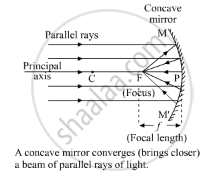Advertisements
Advertisements
प्रश्न
Draw diagram to represent the action of a concave mirror on a beam of parallel light rays. Mark on this diagram principal axis, focus F, centre of curvature C, pole P and focal length f, of the concave mirror.
उत्तर
Ray Diagram-

APPEARS IN
संबंधित प्रश्न
Three students A, B and C focussed a distant building on a screen with the help of a concave mirror. To determine focal length of the concave mirror they measured the distances as given below:
Student A : From mirror to the screen
Student B : From building to the screen
Student C : From building to the mirror
Who measured the focal length correctly ;
(a) Only A
(b) Only B
(c) A and B
(d) B and C
An object is placed at a distance of 12 cm in front of a concave mirror of radius of curvature 30 cm. List four characteristics of the image formed by the mirror.
Fill in the following blank with suitable word:
A concave mirror .......... rays of light whereas convex mirror ............ rays
For what position of an object, a real and diminished image is formed by a concave mirror?
Draw the following diagram in your answer book and show the formation of image with the help of suitable rays:
Make labelled ray diagrams to illustrate the formation of:
a virtual image by a converging mirror.
Mark clearly the pole, focus, centre of curvature and position of object in each case.
An object is placed at a distance of 10 cm from a concave mirror of focal length 20 cm.
State two characteristics of the image formed.
An object at a distance of 30 cm from a
concave mirror gets its image at the same point. The focal length of the mirror is ______.
A concave mirror of radius 30 cm is placed in water. It’s focal length in air and water differ by ______.
You are provided with a convex mirror, a concave mirror, a convex lens and a concave lens. You can get an inverted image from
